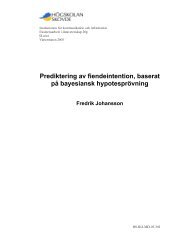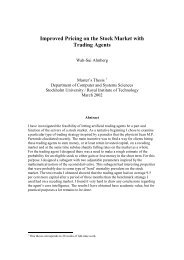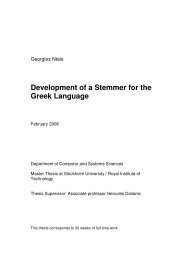22 Chapter 6. Models and methodssummation, as described <strong>in</strong> Section 3.2.1. Albeit a common reflex property, <strong>in</strong>dicationof spatial summation <strong>in</strong> <strong>Hydra</strong> was not found <strong>in</strong> the literature, and thus it did not seemmotivated to use such an approach.6.1.3 Proprioceptive sensory systemAs mentioned <strong>in</strong> Chapter 5, the proprioceptive sensory system of <strong>Hydra</strong> monitors the nutritionalstate as well as the adapted light condition of the animal. Clearly, these propertiesshould ideally be implemented also <strong>in</strong> a model of the animal. One problem with try<strong>in</strong>g tomodel the adapted light condition of <strong>Hydra</strong> is that, as po<strong>in</strong>ted out <strong>in</strong> Section 5.1.2, thereis only <strong>in</strong>direct evidence of photoreceptors <strong>in</strong> <strong>Hydra</strong>. Also, the data found <strong>in</strong> the literatureconcern<strong>in</strong>g the <strong>in</strong>fluence of adapted light condition on behavior does not conta<strong>in</strong><strong>in</strong>formation on background illum<strong>in</strong>ation conditions [46]. Due to the two factors just mentioned,the adapted light condition was left out <strong>in</strong> this project, and thus only the nutritionalstate of <strong>Hydra</strong> was modeled <strong>in</strong> the proprioceptive sensory system. Dur<strong>in</strong>g simulations thenutritional state, M h , is updated accord<strong>in</strong>g to(M h (t + dt) = max 0, M h (t) − dt h )max(6.4)f maxdur<strong>in</strong>g feed<strong>in</strong>g, andM h (t + dt) = m<strong>in</strong> (h max , M h (t) + dt) (6.5)if another behavior is active. The upper limit imposed on M h , h max , corresponds tomaximum allowed starvation time, and f max corresponds to the maximum duration offeed<strong>in</strong>g (see Section 5.1.3). Thus, the decrease <strong>in</strong> M h dur<strong>in</strong>g feed<strong>in</strong>g is hmaxf maxunits persecond. See Table 6.3 <strong>in</strong> Section 6.1.6 for parameter values.6.1.4 Motivational stateAs described <strong>in</strong> Section 3.1, it is the motivational state of an animal that give rise tobehavior. Consistently with this theory, the motivational state variables of the simulated<strong>Hydra</strong>, are taken as the union of the animal’s exteroceptive sensory system, as described<strong>in</strong> Section 6.1.2, its proprioceptive sensory system, as described <strong>in</strong> Section 6.1.3, and itscurrent active behavior. The motivational state variables are summarized <strong>in</strong> Table 6.2below.6.1.5 EnvironmentSimulations of the modeled <strong>Hydra</strong> were carried out <strong>in</strong> a 2D-environment. A squareshapedarena with side-length S and periodic boundary conditions were used. Two alternativesfor the representation of light, mechanical, and chemical stimuli <strong>in</strong> <strong>Hydra</strong>’s
6.1. The simulated system 23Table 6.2: Motivational state variables for the simulated <strong>Hydra</strong>.Variable Range DescriptionM l [0, 1] Read<strong>in</strong>g of light sensorM m [0, 1] Read<strong>in</strong>g of touch sensorM c [0, 1] Read<strong>in</strong>g of GSH sensorM h [0, h max ] Nutritional stateM beh B1,B2,B3,B4 Current active behaviorenvironment were implemented: (1) Representation of stimuli <strong>in</strong> terms of objects, wherethe size, position and <strong>in</strong>tensity of each stimulus is varied accord<strong>in</strong>g to a pre-def<strong>in</strong>ed rule.(2) Sensor read<strong>in</strong>gs taken, dur<strong>in</strong>g simulation, from a file conta<strong>in</strong>g stored values for eachtime step. In the first case, the environment of <strong>Hydra</strong> can be represented, e.g., <strong>in</strong> termsof stochastic processes, whereas the second alternative may be used for simulat<strong>in</strong>g <strong>Hydra</strong>dur<strong>in</strong>g a pre-def<strong>in</strong>ed stimuli sett<strong>in</strong>g. A screenshot of the simulation environment can beseen <strong>in</strong> Fig. 6.2.Figure 6.2: The simulated <strong>Hydra</strong> and environment.





